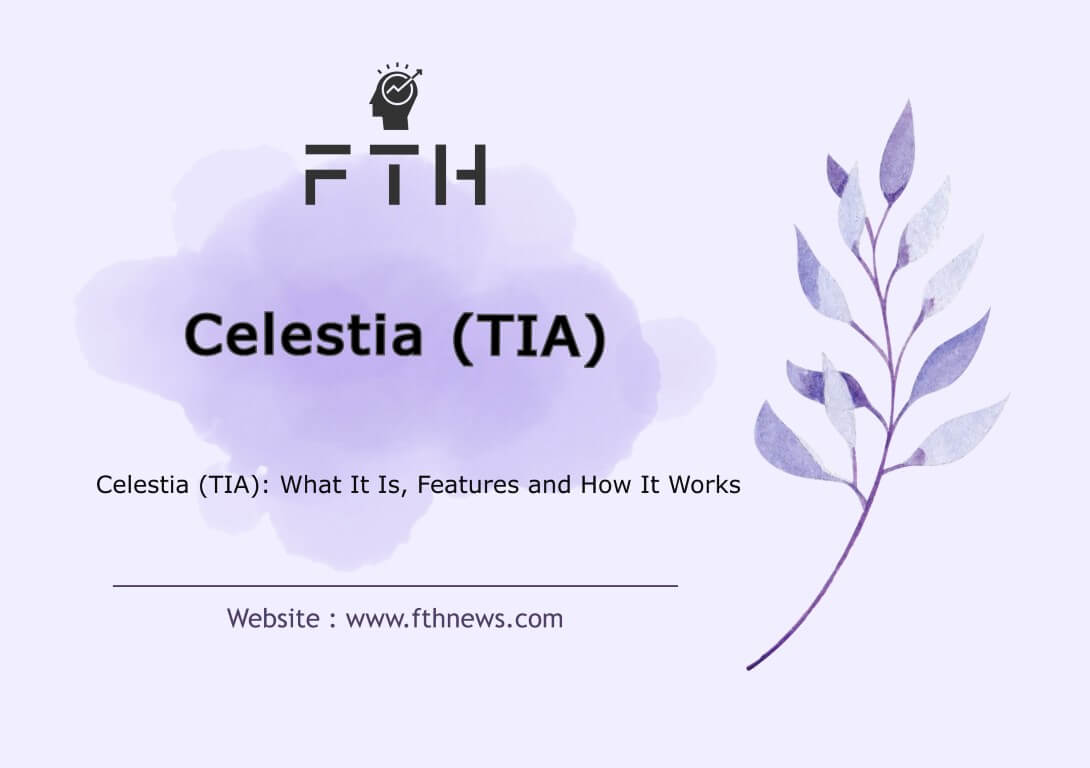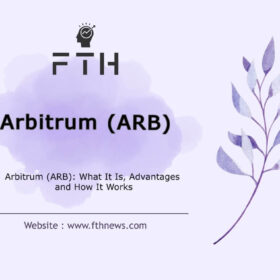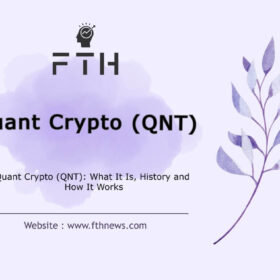
Celestia (TIA): What It Is, Features and How It Works
The Celestia network distinguishes itself as the inaugural modular network that effectively segregates the consensus and data layers. Its primary aim is to enhance the scalability and security of web 3.3 applications. Notably, Celestia deviates from the functionalities of conventional layer 1 blockchains; its sole purpose revolves around ordering transactions and verifying data availability. In this article, we delve into the intricacies of the Celestia network, exploring its features, functionality, and various aspects such as the Celestia token, development team, roadmap, collaborations, and project investors.
However, most traditional blockchains do not afford developers the opportunity to construct additional blockchains within their network. Essentially, this implies that companies seeking to develop their blockchains must embark on the arduous task of starting from scratch.
As the demand for blockchain technology burgeons, there arises an increasing necessity for a framework that enables businesses to launch customized blockchains without the need for ground-up development. The Celestia Network Project appears to be challenging this norm by introducing its modular blockchain network— the Celestia Network.
Understanding the Celestia (TIA) Network:
Celestia operates as a streamlined blockchain network, exclusively managing the ordering and publication of transactions, without executing them. Through the strategic separation of consensus and application execution layers, Celestia modularizes the blockchain technology stack, offering novel possibilities to decentralized application developers. This approach empowers independent blockchains to liberate themselves from the constraints of monolithic architectures, allowing for tailored solutions that align with specific needs and flexible functionalities, thereby streamlining the establishment of new blockchains.
Unfortunately, Ethereum still poses challenges due to its associated costs, and gas expenses on Ethereum’s second-layer projects remain relatively high.
In contrast, many of today’s blockchains are integrated, with transaction execution and consensus confirmation occurring simultaneously through the same set of validators. Scaling such monolithic architectures proves challenging. Celestia revolutionizes this landscape by effectively separating the critical components of the network, offering a pathway to streamlined scalability.
Features of the Celestia (TIA) Network Project:
As highlighted in the preceding section, the central feature that defines the Celestia network is its modularity, a characteristic that facilitates the seamless establishment and operation of new blockchains without the burden of initial setup. This fundamental attribute harbors numerous positive features within its core, which we will now delve into as we explore the distinctive features of the Celestia Network Project.
1. Establishing a New Blockchain:
Celestia’s network architecture empowers developers to deploy customized blockchains tailored to their specific requirements. Instead of embarking on a laborious process from scratch, developers can significantly save time, effort, and resources by effortlessly setting up their blockchain on Celestia’s network. According to information available on Celestia’s website, the deployment process is as straightforward as deploying a smart contract.
2. Customization of Consensus and Security Features:
Developers using the Celestia network can personalize the blockchains they deploy and choose the preferred consensus mechanism for user activities on their blockchain. The Celestia Network Project offers the flexibility for developers to leverage consensus and security features, claiming to provide “consensus and security on demand.” This enables the deployment of a blockchain without the need to initiate an entirely new consensus network.
3. Custom Execution Environment:
Celestia introduces an ecosystem that enables developers to customize their blockchain according to their preferences. The network does not impose a specific implementation logic, allowing developers to choose their own and design an environment that aligns with their needs. The Celestia Network Project supports various rollups as scaling tools, with its architecture primarily built on the Ethereum Virtual Machine (EVM) and the Cosmos SDK network stack.
4. Scalability:
Addressing the critical issue of scalability, the Celestia network diverges from some existing blockchains, such as Ethereum, that grapple with high transaction costs and low transaction speeds. The network tackles scalability through the implementation of rollup, facilitating off-chain execution of transactions. When developers build their chain on Celestia, they can conduct off-network transactions while leveraging the network for consensus. Celestia supports both zero-knowledge proof rollup and optimistic rollup, utilizing innovative methods to enhance scalability.
- Zero-Knowledge Rollups: Utilizing zero-knowledge proofs, these rollups demonstrate the truth of a statement without revealing excessive information.
- Optimistic Rollups: Operating on the assumption that all rollup data is valid, this approach safeguards against attempts to manipulate the system.
In conclusion, the Celestia Network Project stands as a pioneer in offering a modular blockchain network with features that not only streamline the deployment of new blockchains but also provide a high degree of customization, security, and scalability for developers in the web 3.3 ecosystem.
How the Celestia (TIA)Network Operates:
The Celestia network employs a unique approach to enhancing network scalability by increasing the number of users, or light nodes. The key to Celestia’s success lies in maintaining security as long as the network possesses a sufficient number of nodes to sample the entire block of data. This innovative mechanism allows the block size to increase with the addition of more nodes, without compromising security or decentralization — a trade-off often faced by traditional blockchains due to the increased computational requirements for larger block sizes.
Data Availability in Celestia:
Celestia addresses the crucial issue of data availability, a challenge encountered in various blockchain scaling strategies. Data availability, in this context, refers to the ability of nodes to access transaction data. The data availability problem arises when nodes must ensure that newly generated block data has been properly published on the network. If a block producer fails to publish all the data of a block, it becomes challenging to verify the absence of malicious transactions within that block.
Rollups and Celestia’s Role:
Rollups, as a layer 2 scalability solution, aim to offer a more cost-effective platform for applications without compromising security or decentralization. They conduct their transactions independently but leverage other blockchains for consensus and data availability. Celestia significantly contributes to the rollup concept by providing a scalable chain that efficiently distributes data to users at a lower cost.
Modular Architecture:
Celestia stands out with its modular architecture, separating the blockchain stack into specialized components. This unique design divides the main functions — execution and consensus — into distinct layers. Unlike integrated architectures that limit users to a single execution environment, Celestia’s modular approach allows for optimization and specialization for specific use cases. Developers building decentralized applications based on Celestia can benefit from its flexibility, security, and scalability.
Data Availability Sampling:
In Celestia’s modular blockchain, data availability sampling is achieved at a reasonable cost, enabling nodes to confirm a block with the assistance of a smaller sample. For example, confirming a 100 MB block might require only 10 KB of data. This cost-effectiveness allows even devices with minimal processing power, such as smartphones, to function as nodes within the Celestia network.
Devnet Celestia Components:
The Celestia network launched its Development Network (Devnet) in December 2021, comprising three main components:
- Celestia-Node: Responsible for consensus in the blockchain, building new blocks, synchronizing blocks, and sampling block data by light and complete nodes.
- Celestia-App: Manages transaction processing and staking within the network.
- Optimint: Enables the deployment of the Cosmos area as a roll-up. It collects transactions into blocks and sends them to Celestia for consensus.
Early Development Stage:
It’s essential to note that Celestia is currently in the early stages of development. Interested parties can actively participate in the test network as beta developers or node validators by filling out the form on the front page of the Celestia site.
Celestia (TIA) Crypto Roadmap:
Early Development Stage:
2021:
- Attracting Initial Capital
- MVP (Minimum Viable Product) Launch
Second Half of 2021:
- Devnet Launch
2022:
- Setting Up a Test Network
- Incentive System in Experimental Network
2022:
- Setting Up the Main Network
Introduction of Celestia’s Development Team:
Mustafa Al-Bassam (Co-founder and CEO):
- PhD in Blockchain Scalability from UCL
- Co-founder of Chainspace (acquired by Facebook)
Ismail Khoffi (Co-founder and CTO):
- Master’s Degree in Mathematics and Computer Science from the University of Bonn
- Former Senior Engineer at Tendermint Foundation and Interchain
John Adler (Co-founder and CFO):
- PhD in Electrical and Computer Engineering from the University of Toronto
- Researcher at Optimistic Rollups and former Scalability Researcher at ConsenSys
Introduction of Celestia Investors:
Celestia successfully raised $1.5 million in its initial funding round on March 3, 2021. The project boasts a total of 15 investors, with P2P Capital and Signature Ventures being the latest additions. Key investors include:
- Maven 11 Capital
- Cryptium Labs
- Divergence Ventures
- Dokia Capital
- Simon Johnson
- Yield Ventures
- Binance Labs
- KR1
Modular Architecture in the Celestia Network Project:
Traditional blockchains operate on a monolithic architecture where the execution layer, consensus layer, and data availability layer are integrated into the underlying structure. Each layer has its specific responsibilities, such as managing decentralized applications, validating transactions, securing the network, and recording transaction history. However, this integrated architecture tends to have low throughput as it includes information and functions necessary for all layers.
In contrast, the Celestia Network project adopts a modular architecture, allowing developers to customize their execution environments. Unlike the monolithic structure, this modular approach separates the layers, offering increased flexibility and the ability to make changes without necessitating a hard fork. In Celestia’s modular architecture, the basic consensus layer focuses solely on data availability, while transaction verification occurs independently, providing a more efficient and adaptable framework.
Celestia Network Architecture:
The Celestia network’s modular architecture stands in contrast to the traditional, monolithic structure employed by many chains. Developers working within an integrated framework often find themselves constrained by predefined programming languages, limiting customization possibilities. In Celestia’s modular architecture, developers can design their execution environments akin to virtual machines, enabling the customization of blockchains without resorting to hard forks. Celestia, in this context, serves as the Data Availability layer, ensuring the storage and availability of data on the network.
Celestia Network Settlement Layer:
The settlement layer within the Celestia ecosystem is constructed using CEVMOS (Celestia EVMOS). EVMOS is described as a chain based on the Cosmos SDK with a built-in Ethereum Virtual Machine (EVM). CEVMOS, on the other hand, acts as a chain based on EVMOS, serving as a rollup of Celestia and was created via Optimint 59 (not Tendermint).
Optimint, according to project founder Mustafa Al-Bassam, functions as an alternative to Tendermint BFT, allowing developers to create new blockchains utilizing an existing consensus layer and data layer like Celestia. This transforms the new chain into a roll-up, with these rollups functioning on CEVMOS, the settlement layer. CEVMOS then passes the data to the data access layer within Celestia.
Data Availability Layer in the Celestia Network Project:
The data availability layer in Celestia ensures the efficient capture and storage of on-chain generated data in blocks. By keeping this layer separate from others, Celestia works effectively, maintaining the integrity of data without manipulation. This separation allows different blockchains built on Celestia to interact without concerns about data manipulation.
In contrast to concerns voiced by figures like Vitalik Buterin about security risks associated with cross-chain bridges, Celestia’s approach is distinct. Instead of deriving state data from individual chains, Celestia bridges draw from the Celestia Network itself. This reduces the risk of data misalignment, as Celestia is fed data from both chains, offering a more secure foundation for a multi-chain blockchain ecosystem. The utilization of data access layer ensures the reliability of bridges connecting different chains within the Celestia Network.
Launching New Roll-ups in the Celestia Network Project:
The core vision of the Celestia network revolves around simplifying the process of deploying and running a new blockchain, emphasizing ease similar to deploying a smart contract. This innovative approach eliminates the necessity to issue a new token when launching a blockchain, allowing developers to utilize the TIA cryptocurrency for this purpose.
In the Celestia network project ecosystem, similar to the role of ether in other networks, roll-up developers can use TIA digital currency for gas fees and payments, alongside data access, to effortlessly set up their chains. This framework empowers developers to focus on creating applications or the implementation layer for the new token issuance without the complexity of introducing a new token.
Securing the Network with TIA Digital Currency Staking:
Celestia Network employs a proof-of-stake consensus mechanism to secure its network. TIA cryptocurrency holders can actively participate in network security through the digital currency staking process by delegating their tokens to Celestia’s validators. In return, users receive a portion of the validation investment reward, turning TIA ownership into both a governance tool and a potential source of income.
Decentralized Governance of Celestia Network with TIA Cryptocurrency:
TIA’s role in cryptocurrency governance is pivotal in Celestia’s decision-making processes. TIA token holders play an active role in decentralized governance by voting on network parameters through governance proposals. Additionally, they contribute to managing the community pool, which receives a share of block production rewards. This commitment to decentralization ensures that the Celestia community actively shapes the network’s future.
TIA token holders have the ability to participate in voting or propose voting initiatives. To kickstart the network, the community pool allocates 2% of the block mining reward.
How TIA Token Allocation Works:
- Total Supply: The initial total supply of TIA tokens in the network creation stage is one billion tokens, allocated across five different categories for various activities and users.
- Max Supply: There is no limit on the number of tokens (Max Supply) for TIA digital currency.
- Annual Supply Reduction: The TIA token’s annual top premium starts at 8%, decreasing by 10% each subsequent year until the annual generation rate reaches 1.5%.
Distribution Categories:
- Public Allocation (20%): Includes 7.4% for the initial airdrop and project testnet activists, with 12.6% earmarked for future incentives.
- Project and Ecosystem Development (26.8%): Allocated to the Celestia Foundation and main developers for maintaining and developing the network, supporting role developers, infrastructure, and validators.
- Project Celestia Backers (19.7%): Allocated to backers in Series A and B.
- Network Backers in Early Seed Stage (15.9%): Allocated to early seed-stage network backers.
- Celestia Labs Members and Core Activists (17.6%): Allocated to Celestia Labs members and core Celestia Project activists.
This comprehensive distribution strategy ensures a balanced and diverse allocation of TIA tokens across various stakeholders, fostering a robust and inclusive Celestia network.
Distribution of TIA Digital Currency:
The distribution of the TIA digital currency involves several restrictions and release schedules to ensure a controlled and strategic allocation of tokens.
The total supply of one billion TIA digital currencies is governed by specific rules .
TIA Digital Currency Staking:
All TIA currencies, whether locked or free, can be used in the TIA digital currency staking process.
Rewards from staking are free and are added to the circulating supply of project tokens.
Public Allocation:
- Tokens allocated to the public are free from the project’s launch.
Ecosystem Allocation:
- 25% of tokens allocated to the ecosystem are free, while the remaining 75% are continuously released from the first year to the fourth year.
Core Activists and Labs Members Allocation:
- 33% of tokens allocated to the core of early activists and Labs members are released in the first year.
- The remaining 67% are released continuously from the first year to the third year.
Seed Stage and Series A/B Backers Allocation:
- 33% of tokens allocated to project backers in the Seed stage, Series A, and Series B are released in the first year.
- The remaining 67% are released from the first year to the second year.
TIA Digital Currency Airdrop:
The TIA cryptocurrency airdrop targeted a diverse group of participants, including active Ethereum second-layer projects, Cosmos ecosystem projects, and developers active in Ethereum and Cosmos.
Users could register their wallet addresses to receive the airdrop by October 17, 2023.
A snapshot was taken on January 1, 2023, to determine eligibility.
20 million tokens from the airdrop were reserved for the top 50% of users of the top 10 Ethereum rollups, based on factors such as the number of transactions, months of activity, fees used, and contracts.
Another 20 million TIA tokens were reserved for stakers in Osmosis and Cosmos projects.
An additional 20 million TIA tokens were allocated to developers active in the development of Bitcoin and Ethereum.
TIA digital currency airdrop tokens are sent directly to users’ wallets.
This meticulous distribution strategy ensures fairness, incentivizes participation, and aligns with the vision of creating a vibrant and engaged community within the TIA network.
Conclusion:
TIA emerges as a unique layer one blockchain with a distinct focus on ordering transactions and confirming the availability of published data. This specialization allows the deployment of specific and complex blockchains on its platform. The core idea behind TIA lies in the separation of transaction execution and confirmation from the consensus layer, with TIA handling the essential tasks of ordering transactions and ensuring data availability. Developers can leverage Celestia’s infrastructure to construct decentralized applications or independent blockchains, benefitting from its modular architecture that prioritizes flexibility, security, and scalability. As Celestia progresses through its roadmap, it aims to transition from the test network to the main network, introducing innovative features and refining its capabilities.
FAQ
Celestia in crypto refers to the Celestia Network, a modular blockchain project aiming to enhance scalability and security for web 3.0 applications. It provides a unique approach by separating the consensus and data layers, offering flexibility for developers in deploying customized blockchains.
Yes, Celestia has its native token called TIA. It plays a crucial role in network security through staking, governance, and other functionalities within the Celestia ecosystem.
Yes, Celestia is a blockchain. It distinguishes itself by adopting a modular architecture, separating consensus and data layers, providing increased flexibility for developers.
Celestia has a total token supply of one billion TIA tokens. The distribution is strategic, allocated across different categories to support various activities and users within the Celestia Network.
Celestia operates independently and is not built on the Ethereum blockchain. It utilizes its modular architecture to enhance scalability and flexibility.














